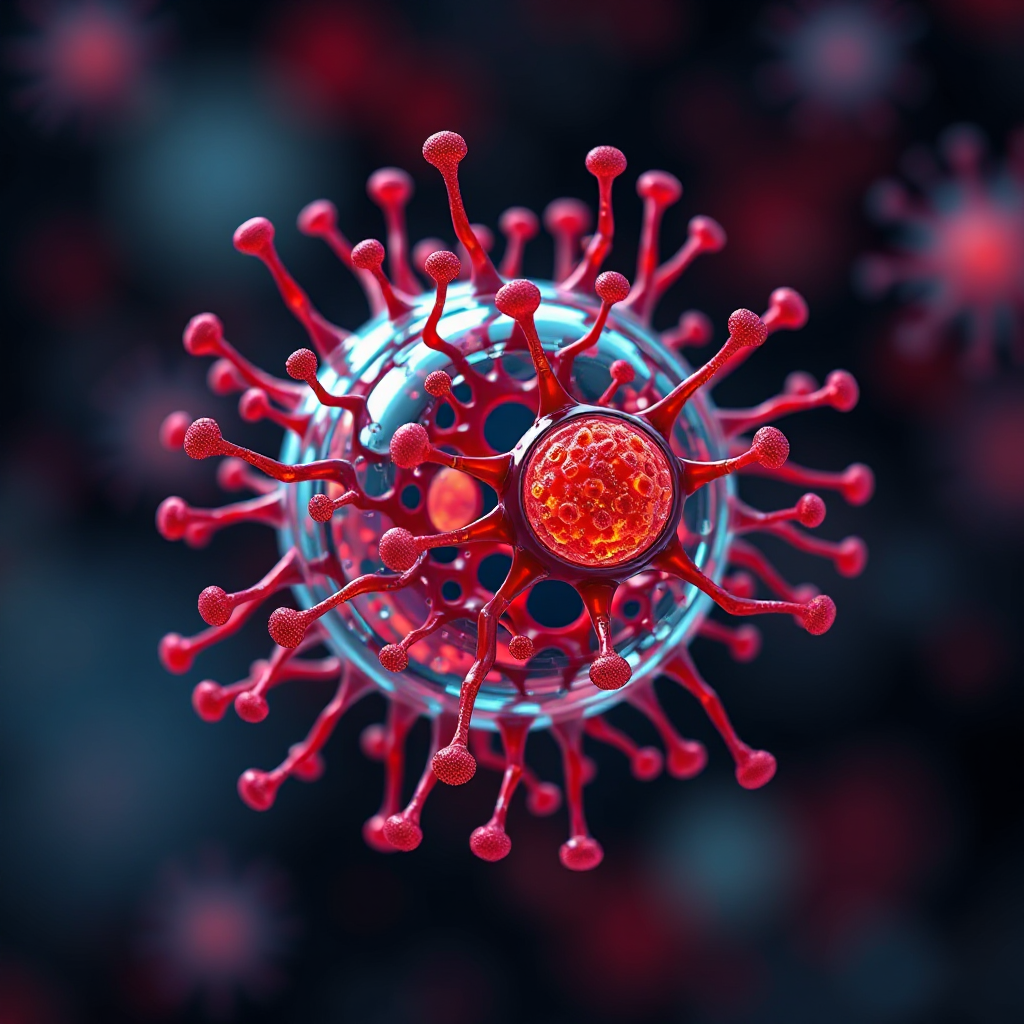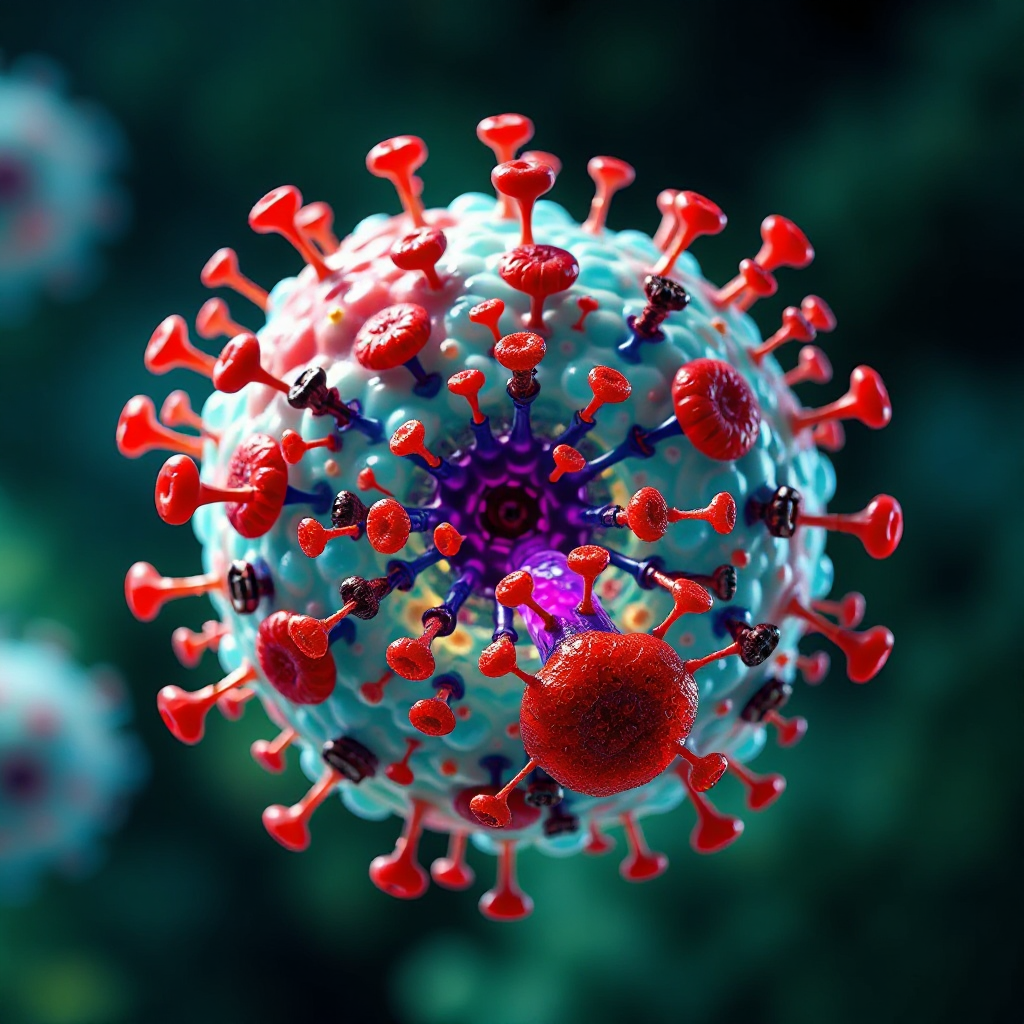Understanding T-Cell Prolymphocytic Leukemia and Its Symptoms

T-cell prolymphocytic leukemia (T-PLL) is a rare and aggressive form of mature T-cell leukemia. It accounts for about 2% of all chronic leukemias in adults and is more common in individuals over 65 years old. This disease progresses rapidly, making early recognition of symptoms essential. Identifying signs early allows doctors to diagnose and treat the condition promptly, improving survival rates and quality of life. While some individuals may experience an inactive phase of the disease, most cases progress to active disease within two years, requiring timely medical intervention.
Key Takeaways
Look for early signs of T-PLL like feeling very tired, swollen glands, or sweating at night. Finding it early can help with better treatment.
Know that T-PLL happens more often in people over 65. It might also run in families. Talk to your doctor about your family’s health history to check your risk.
Go to the doctor quickly if you have bad symptoms. These include getting sick often or losing weight without trying. These might mean the disease is getting worse and needs fast care.
Learn about treatments like chemotherapy, immunotherapy, or stem cell transplants. Each works differently depending on the person.
Keep up with new research and treatments for T-PLL. New ideas might bring better results and care made just for you.
Symptoms of T-Cell Prolymphocytic Leukemia

Common Symptoms
Fatigue and Weakness
You may feel unusually tired or weak if you have T-cell prolymphocytic leukemia. This fatigue often persists even after rest and can interfere with daily activities. Studies show that fatigue affects 70–80% of patients with this condition, making it one of the most common symptoms.
Swollen Lymph Nodes
Swollen lymph nodes, particularly in the neck, armpits, or groin, are another common sign. These nodes may feel firm or tender to the touch. About 50–60% of individuals with T-cell prolymphocytic leukemia experience this symptom.
Enlarged Spleen (Splenomegaly) or Liver (Hepatomegaly)
An enlarged spleen or liver can cause discomfort or a feeling of fullness in your abdomen. Splenomegaly is especially prevalent, affecting 75–85% of patients. Hepatomegaly occurs in 40–50% of cases. These symptoms may also lead to reduced appetite.
Fever and Night Sweats
You might notice recurring fevers or wake up drenched in sweat at night. These symptoms occur in 30–50% of patients and often indicate the body's response to the disease. While they may seem mild, they can significantly impact your sleep and overall well-being.
Symptom | Prevalence (%) |
|---|---|
Fatigue | 70–80 |
Swollen lymph nodes | 50–60 |
Splenomegaly | 75–85 |
Hepatomegaly | 40–50 |
Fever | 30–40 |
Night sweats | 40–50 |
Severe Symptoms
Frequent Infections
T-cell prolymphocytic leukemia weakens your immune system, making you more prone to infections. These infections can become severe and life-threatening if not treated promptly. Recurrent infections affect 60–70% of patients and require immediate medical attention.
Unexplained Weight Loss
You may notice a sudden drop in weight without changes to your diet or exercise. This symptom affects 50–60% of individuals and often signals the disease's progression.
Skin Rashes or Lesions
Skin involvement is another possible symptom. You might develop rashes, lesions, or other abnormalities on your skin. These changes can vary in appearance and may cause discomfort or itching.
Anemia and Low Platelet Counts (Thrombocytopenia)
Anemia can leave you feeling weak or short of breath, while low platelet counts may lead to easy bruising or abnormal bleeding. These symptoms can significantly impact your quality of life and may require supportive care.
Symptom Type | Description | Patient Impact |
|---|---|---|
Severe Symptoms | Recurrent infections and abnormal bleeding | Life-threatening, requires immediate attention |
Common Symptoms | Easy bruising due to reduced platelet levels | Less severe, affects quality of life |
Causes and Risk Factors of T-PLL
Genetic Mutations
Genetic mutations play a significant role in the development of T-cell prolymphocytic leukemia. These mutations disrupt normal cell functions, leading to uncontrolled growth of T-cells. Several mutations are frequently associated with this condition:
Genetic Mutation | Frequency/Details |
|---|---|
SAMHD1 | Recurrently mutated |
ATM | Deleted or mutated in up to 70% of cases |
Chromosome 8 | Various lesions, including idic(8p), t(8;8)(p21;q11), trisomy 8q |
CDKN1B | Deletions on chromosome 12p13 |
TP53 | Deletions on 17p13.1 |
JAK/STAT pathway | Recurrent mutations identified |
Additionally, mutations in the JAK/STAT pathway are common. For example:
JAK3M511I mutant protein is found in 53–62% of cases.
JAK1 mutations are less frequent, appearing in 6–10% of cases.
These genetic changes highlight the complexity of T-PLL and its aggressive nature.
Age and Gender
Age is a critical risk factor for T-cell prolymphocytic leukemia. You are more likely to develop this condition if you are over 60 years old. This increased risk stems from the accumulation of genetic mutations and a weakened immune system as you age. While T-PLL affects both men and women, it appears slightly more common in men. This suggests that gender may influence susceptibility, though the exact reasons remain unclear.
Other Risk Factors
Family History of Blood Cancers
A family history of blood cancers may increase your risk of developing T-PLL. This connection suggests a potential genetic predisposition. If close relatives have experienced similar conditions, you should discuss this with your doctor.
Exposure to Chemicals or Radiation
Environmental factors also contribute to your risk. Prolonged exposure to chemicals like pesticides or industrial solvents can increase the likelihood of blood-related cancers. Radiation exposure is another known risk factor. Maintaining overall health and minimizing contact with harmful substances may help reduce your risk.
Tip: While lifestyle factors like diet or exercise are not strongly linked to T-PLL, a healthy lifestyle can support your immune system and overall well-being.
Diagnosis of T-Cell Prolymphocytic Leukemia
Initial Medical Evaluation
Physical Examination
Your doctor will begin by performing a thorough physical examination. They will check for signs like swollen lymph nodes, an enlarged spleen, or skin abnormalities. These findings often provide the first clues that point toward T-cell prolymphocytic leukemia.
Review of Medical History
A detailed review of your medical history helps identify risk factors, such as a family history of blood cancers or prior exposure to harmful chemicals. This step also ensures that your symptoms are not linked to other conditions.
Diagnostic Tests
Blood Tests to Check White Blood Cell Counts
Blood tests play a critical role in diagnosing T-PLL. They often reveal elevated white blood cell counts, low red blood cell counts, and reduced platelet levels. These abnormalities indicate disruptions in normal blood cell production. Additionally, chromosomal changes, particularly involving chromosome 14, may be detected.
Bone Marrow Biopsy
A bone marrow biopsy confirms the diagnosis by identifying the infiltration of abnormal T-cells. This test also helps distinguish T-PLL from other types of leukemia.
Imaging Tests (e.g., CT Scans)
Imaging tests like CT scans or PET scans help assess the extent of the disease. They can detect enlarged lymph nodes, spleen, or liver, providing a clearer picture of how the disease has progressed.
Complete Blood Count (CBC) |
Peripheral Blood Smear |
Bone Marrow Biopsy |
Immunophenotyping by Flow Cytometry |
Cytogenetics (Karyotyping/FISH) |
Molecular Testing |
Computerized Tomography (CT) Scans |
Positron Emission Tomography (PET) |
Genetic Testing
Identifying Specific Mutations in T-Cells
Genetic testing identifies mutations that drive T-PLL. For example, ATM deletions occur in 69% of cases, while TP53 mutations appear in 14%. These findings not only confirm the diagnosis but also guide treatment decisions. Some mutations, like those in the JAK3 gene, may even predict how aggressive the disease will be.
Finding | Percentage (%) |
|---|---|
Genetic abnormalities in T-PLL | 100 |
TCRA/D locus involvement | 86 |
ATM deletions | 69 |
TP53 deletions | 31 |
i(8)(q10) observed | 61 |
ATM mutations | 73 |
TP53 mutations | 14 |
JAK1 mutations | 6 |
JAK3 mutations | 21 |
BCOR mutations (first time) | 8 |
JAK3 as prognostic marker | Significant negative impact |
Note: Early and accurate diagnosis is essential for managing T-cell prolymphocytic leukemia effectively. If you notice persistent symptoms, consult your doctor promptly.
Treatment Options for T-Cell Prolymphocytic Leukemia

Standard Therapies
Chemotherapy
Chemotherapy is one of the primary treatments for T-cell prolymphocytic leukemia. Doctors often use the CHOP regimen, which includes cyclophosphamide, doxorubicin, vincristine, and prednisone. This combination has proven effective in managing the disease. Other options include alkylating agents and purine analogues. Drugs like pentostatin and bendamustine are also commonly used.
Chemotherapy Agent | Response Rate (%) | Median Survival (Months) |
|---|---|---|
CHOP Regimen | 50–60 | 12–18 |
Pentostatin | 40–50 | 10–14 |
Bendamustine | 30–40 | 8–12 |
Immunotherapy
Immunotherapy boosts your immune system to fight cancer cells. Alemtuzumab, a monoclonal antibody, is a widely used option. It targets specific proteins on T-cells, helping to reduce the number of abnormal cells. This therapy can lead to significant improvements, especially when combined with other treatments.
Advanced Treatments
Stem Cell Transplantation
Stem cell transplantation offers a potential cure for T-PLL. This procedure replaces diseased bone marrow with healthy stem cells. Studies show that the 3-year overall survival (OS) rate ranges from 36% to 56%, depending on the study and patient factors.
Study Source | 3-Year OS (%) | 3-Year PFS (%) | Median OS (Months) | Median PFS (Months) |
|---|---|---|---|---|
French Registry | 36 | 26 | N/A | N/A |
EBMT Study | 42 | 30 | 27.8 | 19.2 |
Single-center Study | 56 | N/A | 56 | 15 |
Targeted Therapies
Targeted therapies focus on specific pathways involved in T-PLL. Drugs targeting the JAK-STAT pathway and AKT inhibitors have shown promise. The AKT inhibitor MK-2206 has demonstrated preclinical efficacy in inducing cell death in leukemic T-cells. A phase II trial of MK-2206 showed a 14% response rate in patients with relapsed or refractory lymphoma, highlighting its potential for T-PLL treatment.
Supportive Care
Managing Symptoms
Supportive care focuses on improving your quality of life. Doctors may prescribe medications to manage symptoms like fatigue, infections, or anemia. Regular monitoring ensures that complications are addressed promptly.
Palliative Care Options
Palliative care provides relief from symptoms and emotional support. This approach helps you maintain comfort and dignity during treatment. It also includes counseling and resources for you and your family.
Tip: Combining standard therapies with advanced treatments and supportive care can improve outcomes and enhance your quality of life.
Prognosis and Survival Rates of T-PLL
Factors Influencing Prognosis
Age and Overall Health
Your age and overall health significantly affect the prognosis of T-cell prolymphocytic leukemia. Patients over 65 years old often face poorer outcomes due to the body's reduced ability to tolerate aggressive treatments. Maintaining good general health can improve your ability to respond to therapies and manage side effects.
Response to Treatment
How well you respond to treatment also plays a critical role in determining your prognosis. Early and effective treatment can slow disease progression and improve survival rates. Factors like high white blood cell counts at diagnosis or specific genetic mutations, such as JAK3, may negatively impact treatment outcomes.
Factor | Influence on Prognosis |
|---|---|
Age > 65 years | Poor outcome associated |
WBC > 40 × 10^9/L at diagnosis | Poor outcome associated |
Short lymphocyte doubling time | Poor outcome associated |
High TCL-1 protein expression | Poor outcome associated |
JAK3 mutations | Significant adverse impact on OS |
Pleural effusion | Increased risk of death |
High absolute lymphocyte count | Increased risk of death |
Complex karyotype | Increased risk of death |
Survival Statistics
Survival rates for T-cell prolymphocytic leukemia vary based on treatment approaches. Patients who undergo stem cell transplantation (SCT) generally have better outcomes. For example:
All SCT patients have a median survival of 48 months.
Non-transplanted patients have a median survival of only 20 months.
The 5-year overall survival (OS) rate for transplanted patients is 34%, compared to 0% for non-transplanted patients.
Study Description | Median Survival | 5-Year OS Rate |
|---|---|---|
All SCT patients | 48 months | 34% |
Non-transplanted patients | 20 months | 0% |
EBMT/Royal Marsden Consortium | 21% (3-year OS) | N/A |
CIBMTR registry | 11.2 months | 48% (1-year OS) |
French SFGM-TC | 36% (3-year OS) | N/A |
Importance of Ongoing Research
Ongoing research aims to improve outcomes for T-cell prolymphocytic leukemia. Scientists are optimizing stem cell transplantation procedures to enhance survival rates. New therapies, such as AKT inhibitors and epigenetic treatments, are being developed to target specific genetic mutations. Researchers are also exploring better options for patients who relapse after initial treatments. These efforts offer hope for more effective and personalized care in the future.
Note: Staying informed about advancements in treatment can help you make better decisions about your care.
Understanding T-cell prolymphocytic leukemia helps you recognize its symptoms, such as persistent fatigue, night sweats, and unexplained weight loss. Causes often include genetic mutations and age-related factors, while treatments involve a multidisciplinary approach, advanced therapies, and lifestyle adjustments. Early detection remains critical for improving outcomes. If you notice concerning symptoms, consult a doctor promptly.
You can find support through resources like HealthTree Connect, which offers networking opportunities and personalized treatment tracking. The Leukemia & Lymphoma Society provides access to clinical trials, financial aid, and caregiver support. These platforms empower you to navigate your journey with confidence.
Tip: Joining support groups or online communities can connect you with others who share similar experiences, offering emotional and practical guidance.
FAQ
What makes T-cell prolymphocytic leukemia different from other leukemias?
T-PLL is rare and aggressive. It originates from mature T-cells, unlike other leukemias that often involve immature blood cells. Its rapid progression and unique genetic mutations set it apart.
How is T-PLL diagnosed?
Doctors use blood tests, bone marrow biopsies, and imaging scans. Genetic testing identifies mutations like ATM or JAK3, which confirm the diagnosis and guide treatment.
Can T-PLL be cured?
Stem cell transplantation offers the best chance for a cure. However, outcomes depend on factors like age, overall health, and response to initial treatments.
What are the early symptoms of T-PLL?
You might notice fatigue, swollen lymph nodes, or night sweats. These symptoms often appear mild but can worsen quickly. Early detection is crucial.
Are there lifestyle changes that help manage T-PLL?
While lifestyle changes cannot cure T-PLL, maintaining a healthy diet and staying active can support your immune system. Regular check-ups ensure timely management of symptoms.
Tip: Always consult your doctor before making significant lifestyle changes.
See Also
A Simple Guide to B-cell Prolymphocytic Leukemia
Exploring Symptoms and Treatments of Large Granular Lymphocytic Leukemia
Defining Acute Lymphoblastic Leukemia and Its Key Symptoms
